Oyster mushrooms are a common wild edible fungi species, and they’re also delicious. They are also becoming more available in supermarkets and farmer’s markets. If you are lucky enough to buy, forage, or grow oyster mushrooms, learning how to cook them is the next step. It’s not complicated to clean or cook oyster mushrooms, but it does help to have a good understanding of their flavor profile, texture, and best preparation methods.
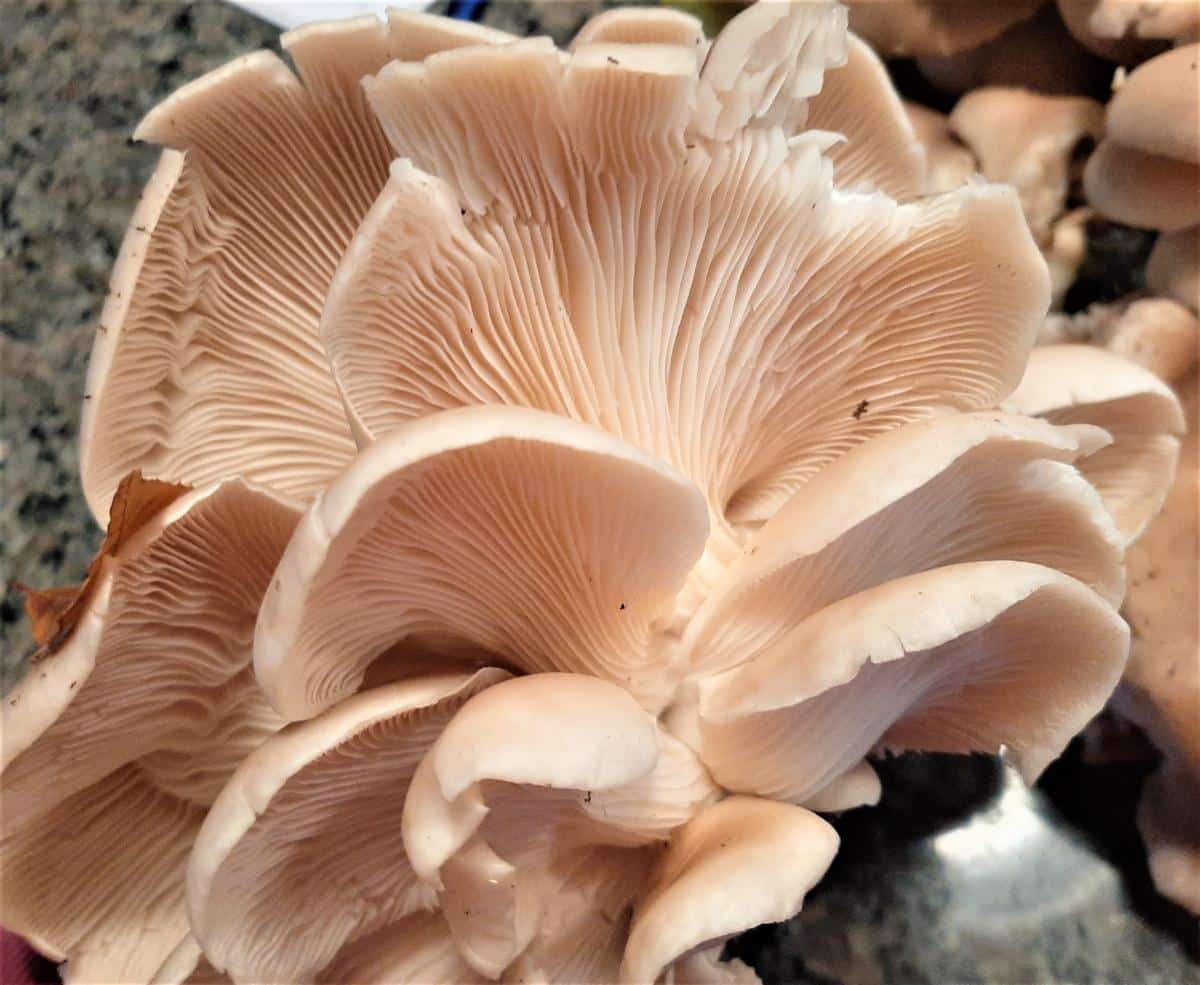
These mushrooms are packed with nutrients like B vitamins, iron, and potassium. They’re also an excellent choice if you are vegetarian or want to include more whole, natural foods in your diet. The price runs higher than regular button mushrooms ($6.99-$7.99 per pound), but their unique taste and nutritional benefits make them worth every penny.
If you don’t have oyster mushrooms at a grocery store or market near you, you can also grow them. They are among the easiest mushrooms to grow, with options from DIY grows to much simpler ready-made kits.

Jump to:
What Are Oyster Mushrooms
Oyster mushrooms got their name from their distinctive fan-shaped caps that look just like seashells. These mushrooms have broad caps that measure 1 to 12 inches wide. They are white to gray and sometimes even tan to dark brown in the wild. Cultivated oyster mushrooms range from yellow to white to pink to grayish-blue.
The caps of oyster mushrooms are smooth with wavy edges and white to cream-colored gills underneath. Their white flesh stays firm and does not change color when cut.
They taste mild and savory. Their smell is unique, too – a slight to strong anise scent that is unmistakable. Young oyster mushrooms taste best – older ones get tough and bitter.

Oyster mushrooms are popular in many culinary traditions. Chinese, Japanese, and Korean chefs love these mushrooms because they have a meaty texture and soak up flavors well. Germans started growing them commercially during World War I to help with food shortages. Now, they are grown in many countries thanks to how easily they adapt.
These mushrooms have a neat secret – they hunt! Their hyphae – tiny filaments on the mycelium – catch and paralyze small organisms like nematodes before eating them. Not many other mushrooms can do this.

Oyster Mushroom Types
There are quite a few edible oyster mushroom species. While not all oyster mushrooms are known to be edible, a lot of these mushrooms are choice-eating. There are both wild and cultivated varieties. Many cultivated types have been developed for specific growth patterns, temperature tolerance, and flavor.
Pearl oyster mushrooms (Pleurotus ostreatus)
The pearl oyster mushroom is the most common type found in North America. The caps are cream-colored to light gray to dark gray and are between 2 and 8 inches wide.
These mushrooms have a sweet and woody flavor. They have a slightly seafood-like aroma and a mild taste. When cooked, their texture is smooth and velvety. Pearl oyster mushrooms are commonly foraged. But, in recent years, commercial cultivation has made them more available.
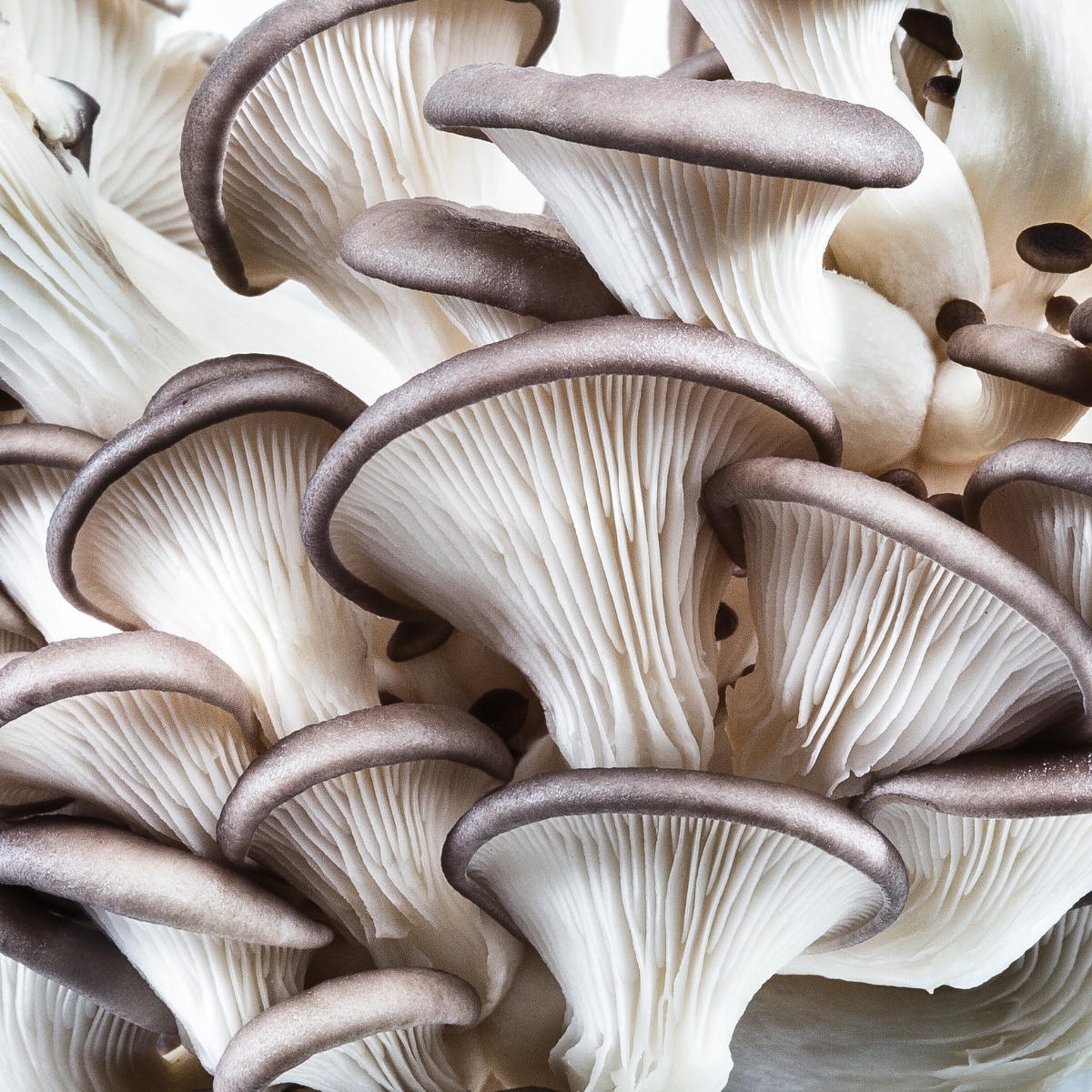
Blue oyster mushrooms (Pleurotus ostreatus var. columinus)
This species prefers cool weather. When grown outdoors, the mushrooms turn a deep blue. They are greyer, though, when grown indoors. They grow in clusters and have 2 to 8-inch wide caps.
Blue oyster mushrooms have a mild and slightly sweet flavor with hints of anise. Their chewy texture makes them a good meat alternative in many recipes.
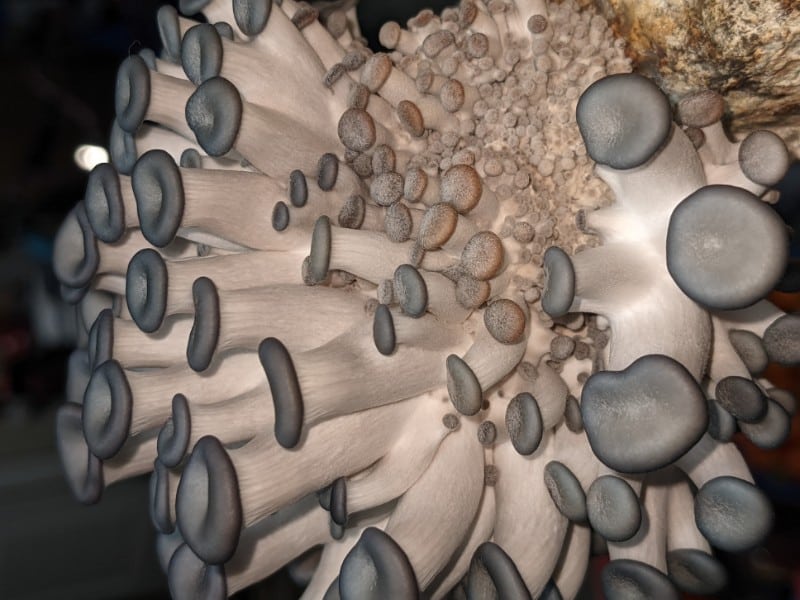
Pink oyster mushrooms (Pleurotus djamor/Pleurotus salmoneo-stramineus)
The incredible pinkness of these mushrooms catches everyone’s eye with their bright color! Pink oyster mushrooms are also known as Flamingo oysters. These mushrooms typically grow in clusters, with individual caps ranging from 2 to 5 inches in diameter. They have a delicate, frilly appearance with a short, off-center stem.
Pink oyster mushrooms have been grown for centuries in different parts of Asia. They have gained popularity around the world in recent years because of their unique color, flavor, and how easy they are to grow. These mushrooms have a soft texture and a mild, slightly sweet taste with hints of woodiness. Sadly, their bright pink color fades when cooked, turning to a more muted beige. They still taste great!
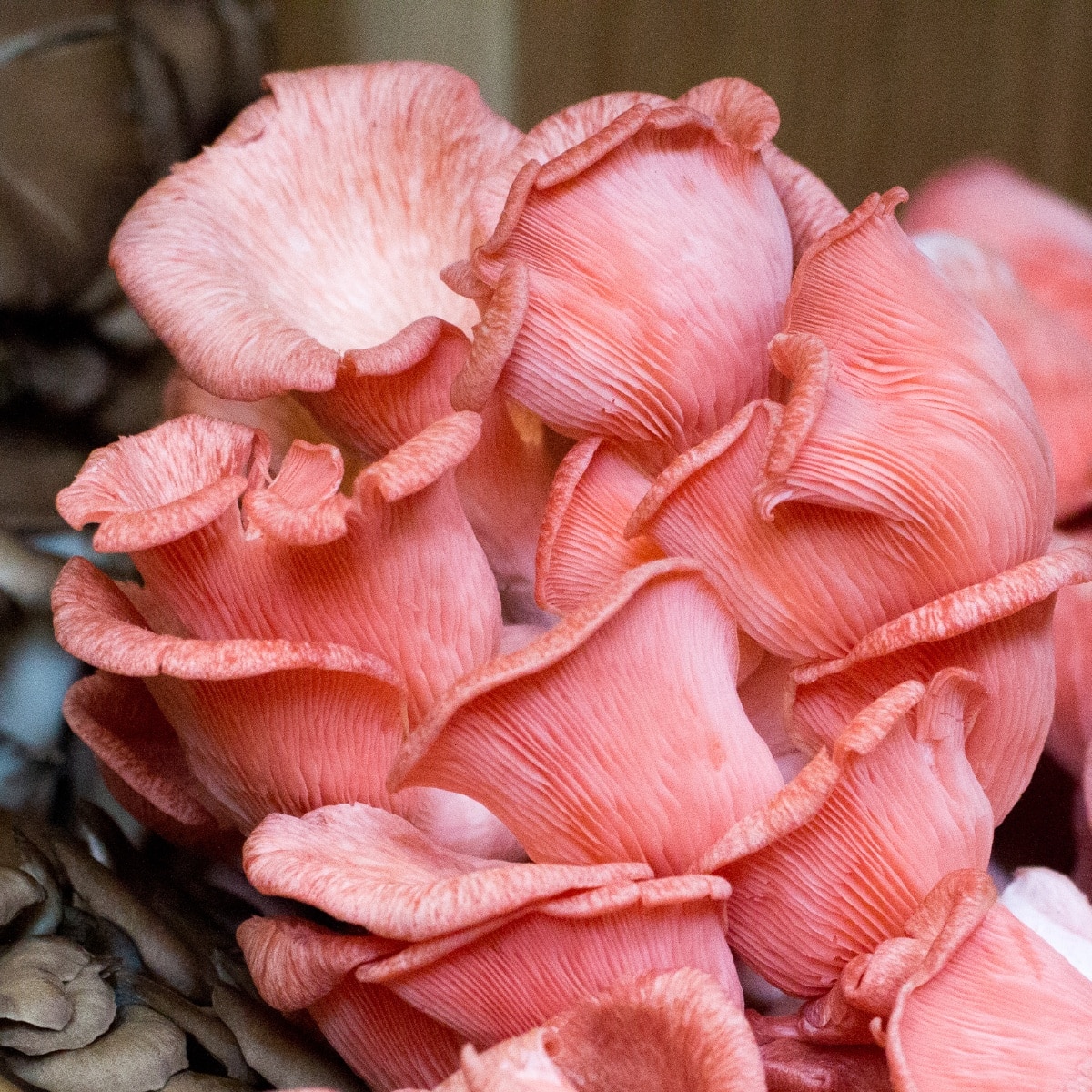
Yellow oyster mushrooms (Pleurotus citrinopileatus)
These mushrooms are a vibrant golden-yellow. They grow in clusters, with caps ranging from 2 to 5 inches wide. Yellow oyster mushrooms are originally from eastern Russia, northern China, and Japan. Recently, they’ve gained popularity all around the world; they’re very popular as grow kits. These mushrooms are sweet and mild with a bit of an anise or licorice flavor. When you cook them, they are tender and meaty.
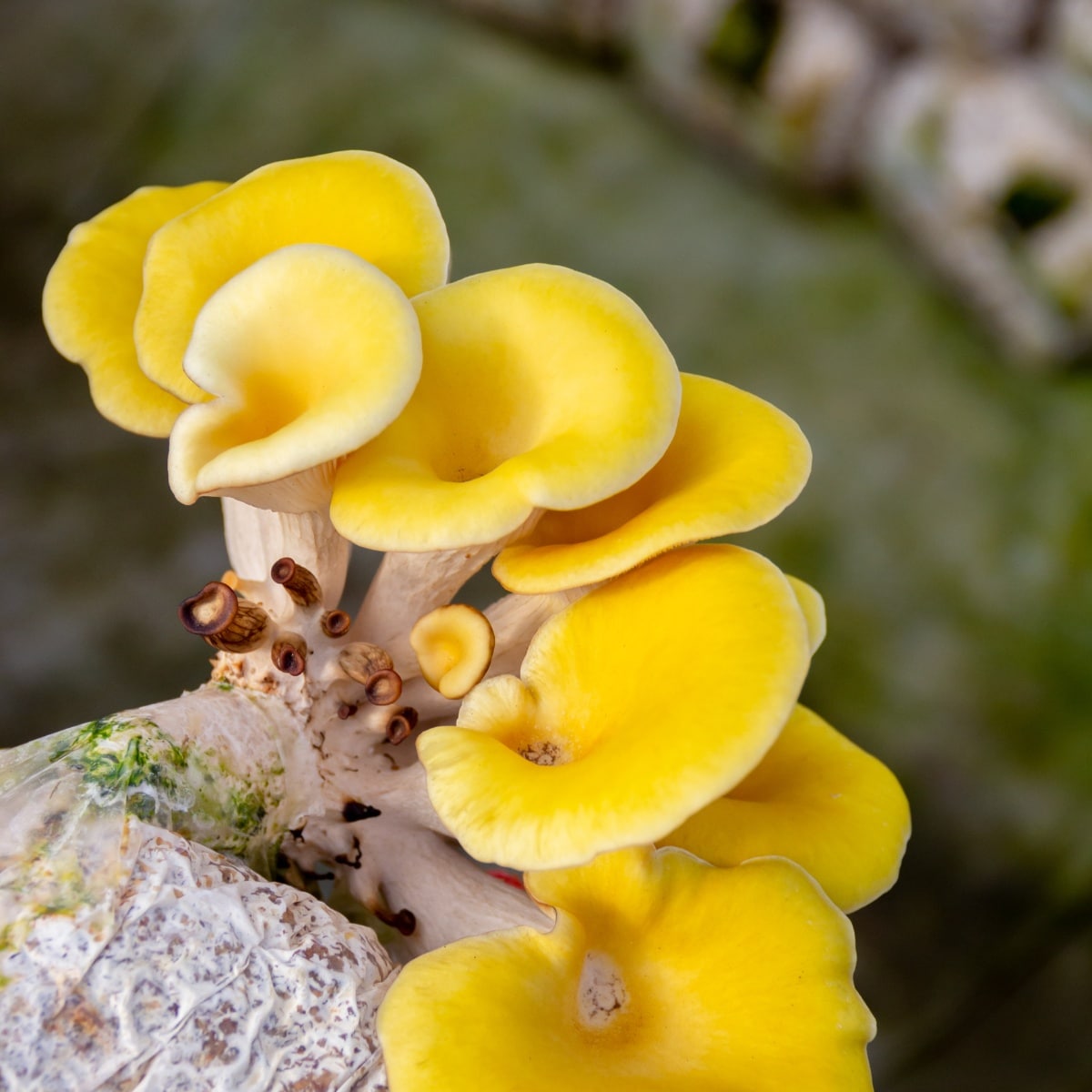
King oyster mushrooms (Pleurotus eryngii)
King oyster mushrooms are also known as king trumpet mushrooms or French horn mushrooms. They are prized for their extremely meaty texture. These mushrooms have thick, white stems that can grow up to 8 inches tall and 2 inches thick.
They have small, tan-colored caps that are dwarfed by the big stem. Unlike many other mushroom varieties where the caps are the main focus, the stems of king oyster mushrooms are the most desirable part due to their firm, dense texture that resembles that of scallops or abalone when sliced and cooked.
King oyster mushrooms come from the Mediterranean and have been cultivated for many decades. They have a mild, savory flavor, and can absorb other flavors well and keep their texture really well when cooked.
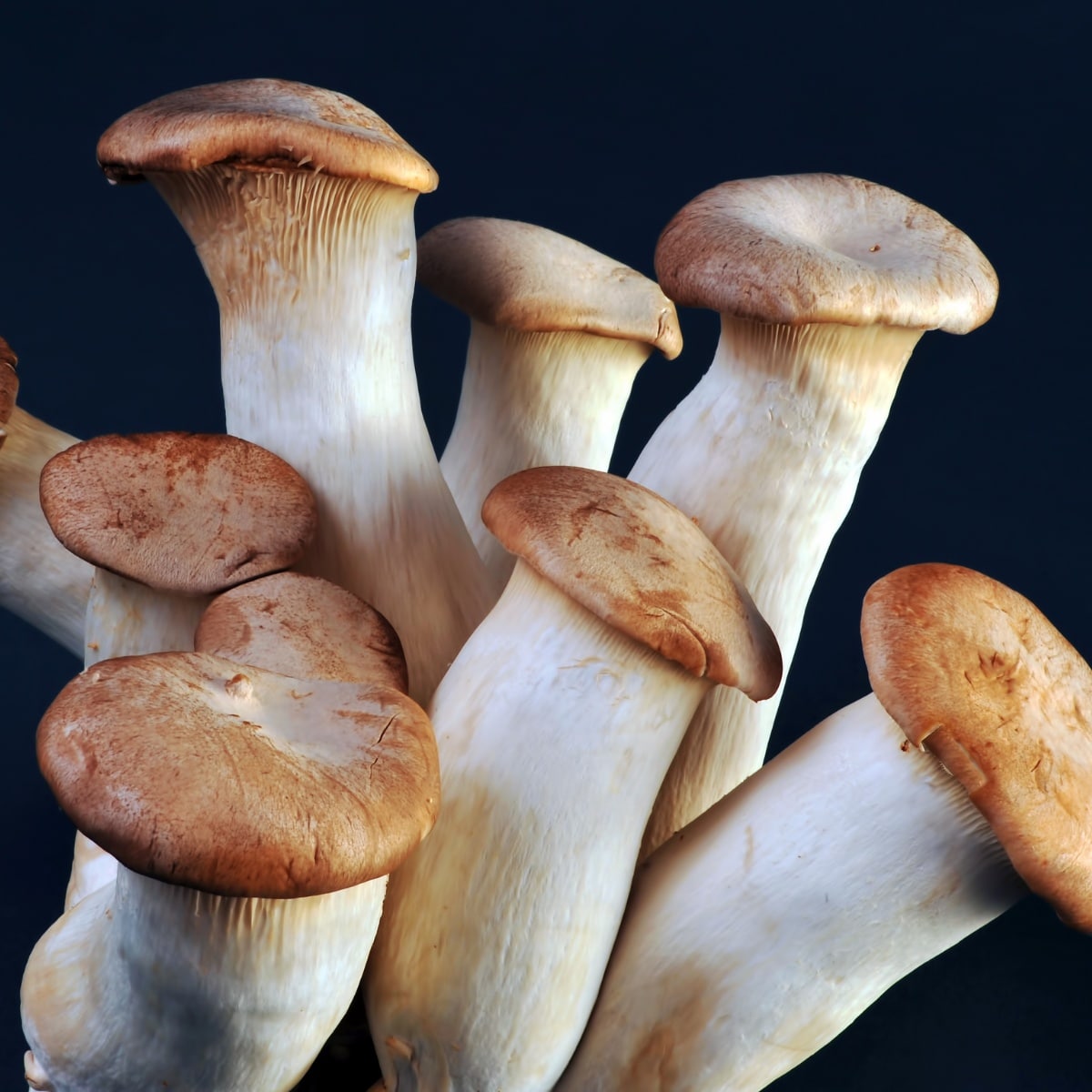
Phoenix oyster mushrooms (Pleurotus pulmonarius)
Phoenix oyster mushrooms, also known as Indian Oyster or Italian Oyster mushrooms, have white to light brown caps and measure 2 to 8 inches wide. They have a tender, meaty texture and mild and subtly sweet flavor.
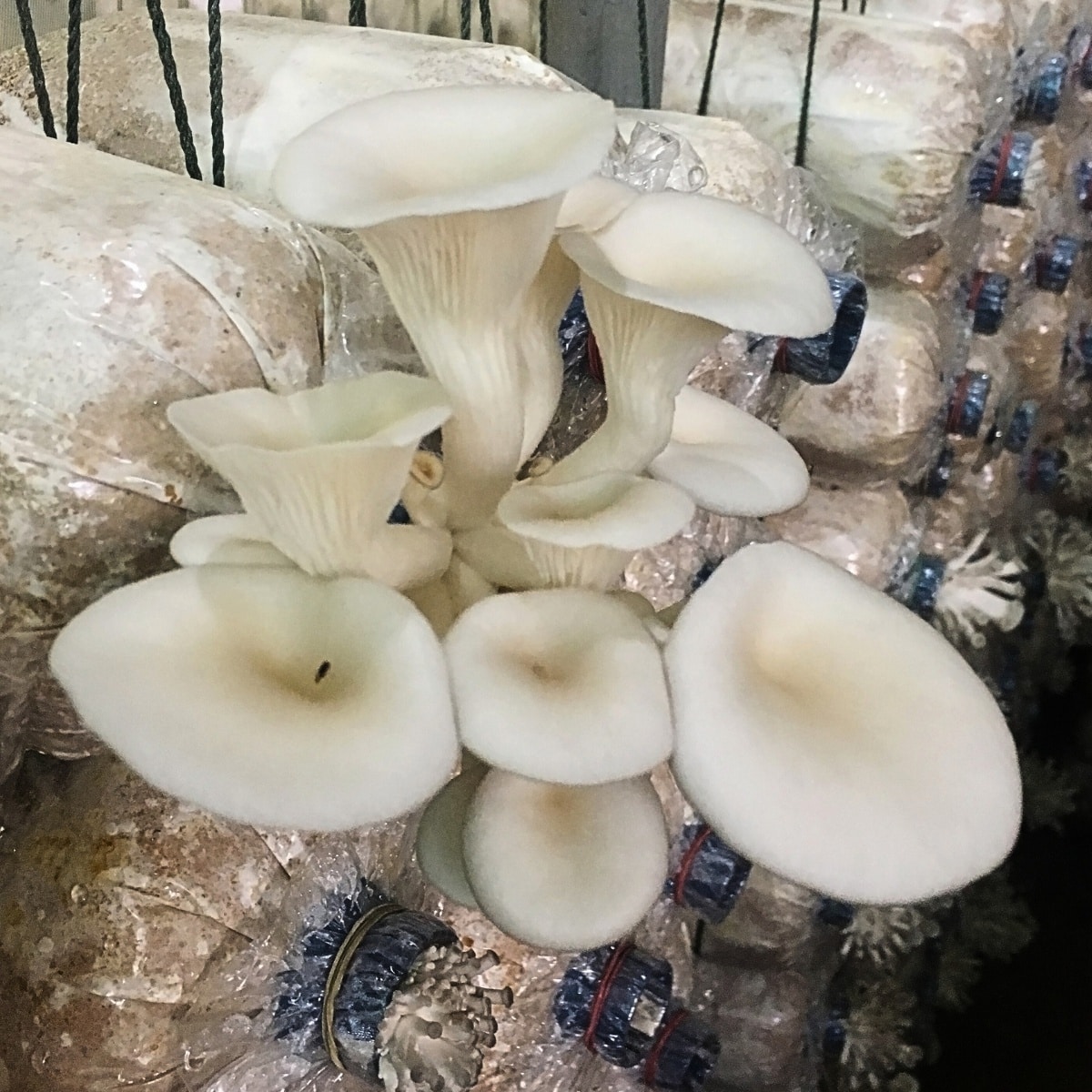
Black oyster mushrooms (Shimofuri)
Black oyster mushrooms grow between 2 and 8 inches wide, and like king oyster mushrooms, are grown for their thick stems. They’re actually a cross between the pearl oyster mushroom and the king trumpet mushroom. They were developed in Japan. They have a mild, slightly sweet flavor and a tender yet meaty texture.
Black oyster mushrooms come from East Asia, mainly Japan and Korea. In recent years, they have gained popularity around the world. They are now grown in North America and Europe, which makes them easier to find.
How to Choose Fresh Oyster Mushrooms
Look for mushrooms that have bright, even colors and feel springy when you touch them. Good mushrooms should be firm and slightly moist, not soggy. Avoid mushrooms with dark spots or wilting, as these signs mean they are going bad. Fresh mushrooms will hold their shape well and be firm.
It’s best to plan your shopping around when you’ll cook. This is because the mushrooms don’t have a super long shelf life. Pink varieties need to be used within two days of harvest. Regular varieties stay fresh for 3-5 days with proper storage.

Wild oyster mushrooms taste best when they’re young. The older ones get tough, super buggy, and don’t usually taste as good. If you’re a forager, keep an eye out for oysters! Oyster mushrooms grow all year in temperate areas. In other places, they’re primarily spring and fall species.
How you store the mushrooms will great affect how well they keep and for how long. Do not clean the mushrooms until you intend to use them. Washing them significantly shortens their life span.
Use paper bags, not plastic bags. Paper bags work best because they let air flow through. Plastic bags allow condensation to build up and the mushrooms to break down and turn moldy quickly.
Oyster mushrooms can dry out faster than other types because they have so much surface area. Plastic containers might help with drying, but be careful – they can create moisture that makes the mushrooms spoil faster. Make sure any plastic container has holes for airflow!
Fresh oyster mushrooms give off a light, anise-like smell when young. This smell tells you they’re fresh and ready to use. Keep these things in mind when choosing oyster mushrooms – looks, feel, smell, and storage needs.
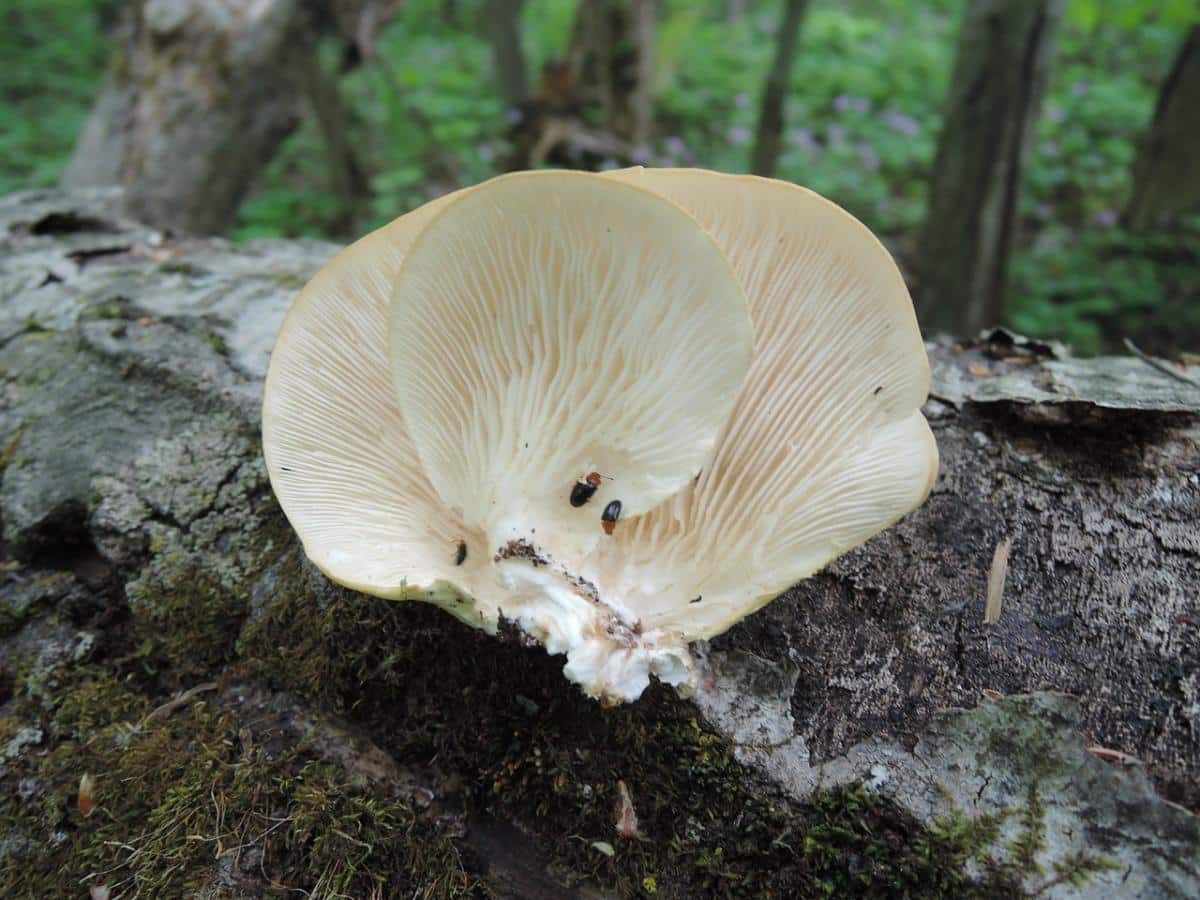
Cleaning and Trimming Oyster Mushrooms
Oyster mushrooms are easier to clean than regular button mushrooms because they grow on wood instead of soil. There are no soil bits or clumps to clean off. Cultivated varieties rarely need anything more than a quick wipe with a damp cloth. Wild foraged oyster mushrooms might have bugs and other debris to wash off.
Take time to look at each mushroom for white fuzz, mold, yellow spots, or yellow slime. A dry paper towel or soft cloth works well to wipe away loose debris. You can use a toothpick to remove stubborn dirt spots and then wipe it with a damp cloth.
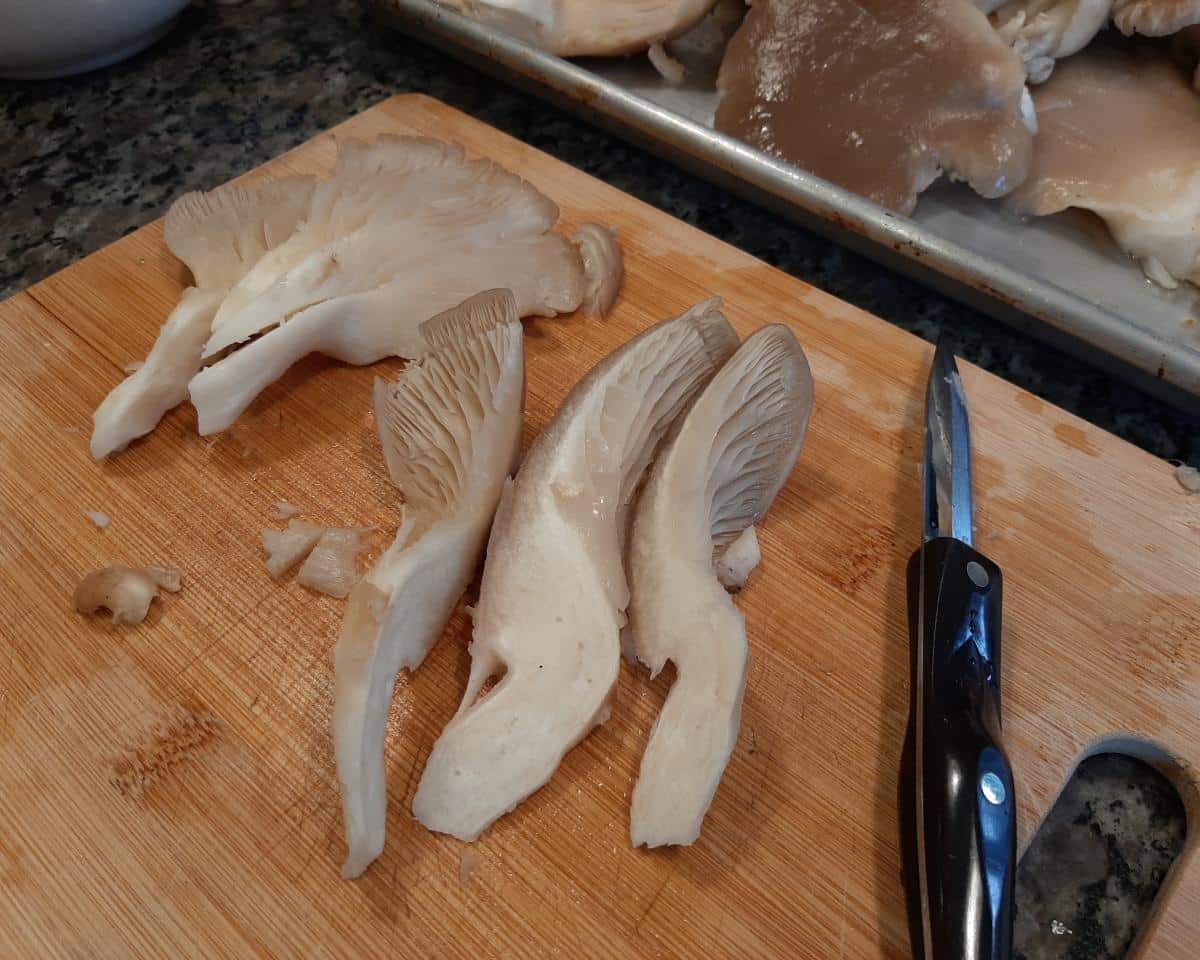
Many say not to submerge or soak oyster mushrooms to clean them because they are like sponges and soak up water. There is some truth to this, but it isn’t a hard and fast rule. A lot depends on how you intend to cook them. When you cook oyster mushrooms by dry sauté, it’s okay if they get a bit soggy.
Soaking the mushrooms might slightly change their texture, but dry sautéing will sort that out. If you plan to cook oyster mushrooms by frying, it’s best to skip the soaking. Just spot-clean the areas that need some extra care.

How To Cut Up An Oyster Mushroom
The first step in learning how to cook oyster mushrooms is to cut off the tough, woody base where the cluster joins together. Separate the individual mushrooms from the central stem. You can use a knife to do this or use your hands and pull them apart.
The cooking method will determine your cutting technique. Smaller mushrooms can be left whole or cut in half. We especially like keeping them whole because this retains their juicy texture and allows them to soak up the flavors of the dish really well.
The stems are valuable, too; don’t throw them out. Stems are an awesome addition to flavor stocks and broths. Chop them up and use them in the next few days. Or, you can store them in the freezer for later.

Storing Cleaned Oyster Mushrooms
It’s best to store cleaned mushrooms in a paper bag in the refrigerator. This allows the mushrooms to breathe and helps preserve their quality. For additional moisture control, you can line a plastic container with paper towels to absorb any excess moisture. Most mushrooms can stay fresh for up to three days when stored properly. However, pink oyster mushrooms are particularly perishable and should be used within 48 hours after cleaning.

How To Cook Oyster Mushrooms
Oyster mushrooms are super adaptable to many cooking methods and cuisines. They can be used as a meat substitute, served on their own, or made into the star of the dish. There are many methods to cook oyster mushrooms, and it’s fun to try them all!

Restaurant-Style Sautéed Oyster Mushrooms
This is a simple, classic recipe that highlights the oyster mushrooms on their own.
- Heat a frying pan and add two tablespoons of oil.
- Spread the mushrooms evenly in the pan.
- Let them cook without touching them for 3-5 minutes on medium-high heat. This original sear creates a delicious crust.
- Turn down the heat to medium-low and stir the mushrooms.
- Add some butter, crushed garlic cloves, and your favorite fresh herbs.
- Cook oyster mushrooms for about five more minutes. Stir them a few times while cooking.
- If you spoon the melted butter over the mushrooms a few times, they soak up all that goodness and turn a rich, dark brown.
Pressed Oyster Mushrooms
This method to cook oyster mushrooms compresses them so they have an even meatier texture. The result is a dense, juicy mushroom cut that rivals real meat.
- Slice the mushrooms into even pieces about a quarter-inch thick.
- Heat a pan on medium-high and add a little oil or butter.
- When the pan is hot, lay the mushroom slices out in a single layer in it.
- Press them down with something heavy, like a cast-iron pan or a smaller pan weighed down with a can.
- Cook the mushrooms for 2-3 minutes until they release moisture and turn golden brown on the bottom.
- Flip the mushrooms and apply gentle pressure for another 1-2 minutes. It is important to keep a close eye on the second side, as it may cook more quickly and burn.
- Remove the mushrooms from the pan once both sides are crispy and golden brown.
- Season them to taste with salt, pepper, and herbs or spices to enhance their flavor.
Fried Oyster Mushrooms
Fry up oyster mushrooms just like fried chicken and you’re in for a surprise! The texture and juiciness is unreal.
- Slice the larger mushrooms into bite-sized pieces. You can leave the smaller ones whole.
- Prepare a batter and dip the mushroom pieces in, making sure they are evenly coated.
- Heat vegetable oil in a deep fryer or a heavy-bottomed pot to 350°F (175°C).
- Carefully lower the battered mushrooms into the hot oil. Work in small batches to avoid overcrowding.
- Fry for about 2-3 minutes or until golden brown and crispy.
- Remove the fried mushrooms and place them on a wire rack or paper towels to drain the excess oil.
- Serve immediately while hot and crispy!

Air Fried Oyster Mushrooms
Air frying the oyster mushrooms as opposed to deep frying is a good healthy alternative. And, when you cook oyster mushrooms like this, it gives really good results too.
- First, prepare the oyster mushrooms like you would for frying by tearing and dipping them in the batter.
- Set the air fryer to 400°F.
- Place the mushroom pieces in a single layer in the air fryer basket. Don’t pack the mushrooms too tight. If they’re too close, they might not get that nice crispy texture all over.
- Spray the tops and sides of the mushrooms with oil, such as avocado or vegetable oil.
- It depends on your air fryer, but they usually need about 15-20 minutes.
- Flip them halfway through so they brown up nicely.
- They’re done when they’re golden brown and crispy around the edges.
Roasted Oyster Mushrooms
Roasting is a classic method to cook oyster mushrooms and works excellently. They have enough moisture that they don’t dry out. And, the roasting gives them nice crispy edges.
- Preheat the oven to 400°F (200°C).
- Clean the mushrooms with a damp cloth or paper towel.
- Tear or cut larger mushrooms into bite-sized pieces. You can leave smaller ones whole.
- Toss the mushrooms in a bowl with olive oil, salt, and pepper.
- Line a baking sheet with parchment paper and spread the seasoned mushrooms in a single layer on it. Make sure they’re not overcrowded to allow for even roasting.
- Roast for about 15-20 minutes.
- Flip the mushrooms halfway through the cooking time.
- Keep an eye on them, as cooking times may vary depending on the size of your mushrooms.
- The mushrooms are done when they’re golden brown and crispy around the edges.
Shredded Oyster Mushrooms (Meat Substitute)
Oyster mushrooms are a great choice for a meat substitute because they’re soft and have a nice, mild flavor.
- Tear them into thin, shredded pieces. If you follow their natural grain, they come apart easily.
- Sauté the shredded mushrooms in a hot skillet with a bit of oil.
- Once they’re cooked, season them with your favorite spices or sauces.
Oyster Mushroom Jerky
Oyster mushroom jerky is phenomenal. When done right, the jerky is dense, chewy, and packed with flavor. This is our favorite oyster mushroom jerky recipe.
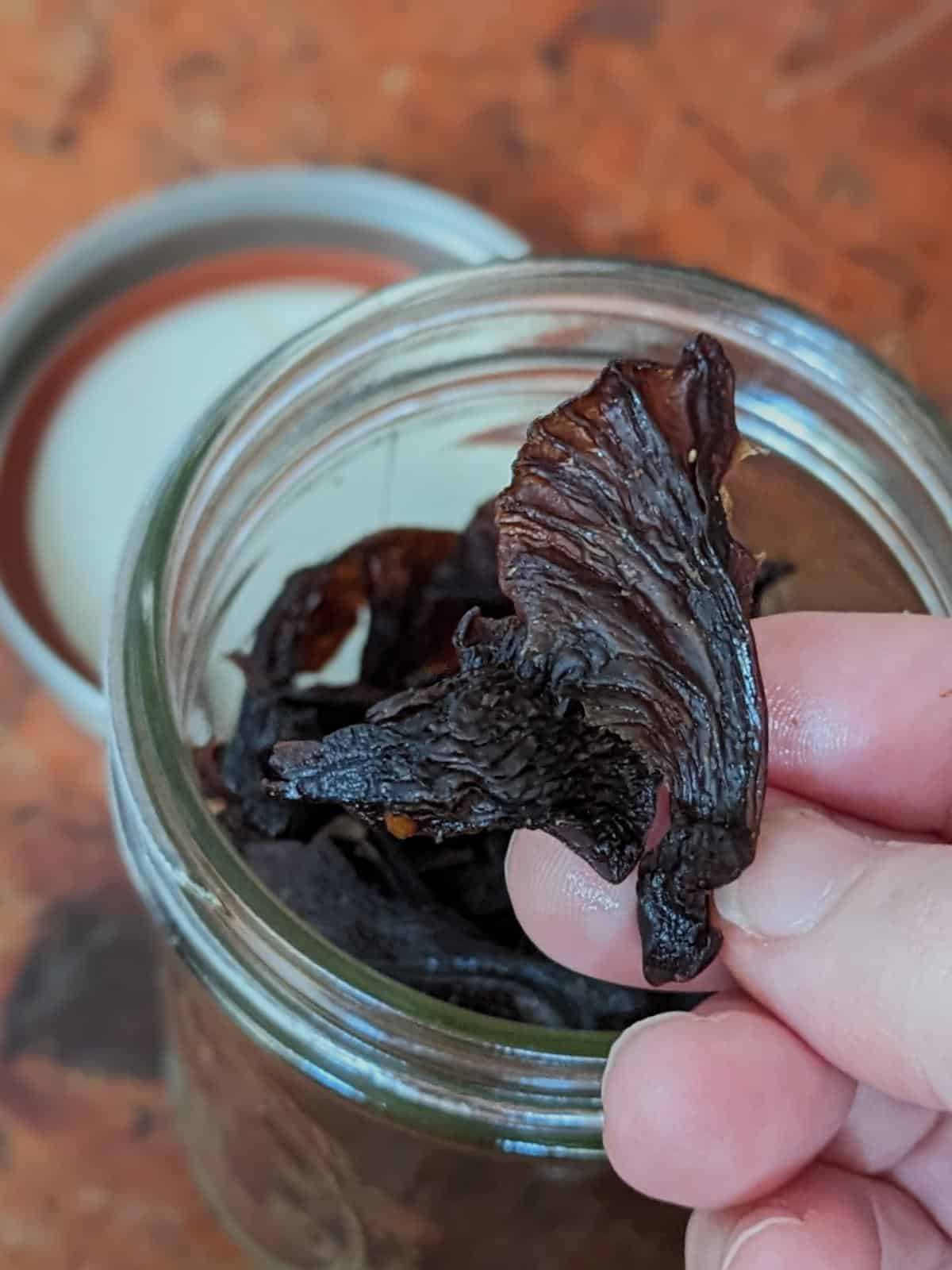
Our Favorite Oyster Mushroom Recipes
Looking for some inspiration and more ways to cook oyster mushrooms? These are some of our favorite recipes:
- Miso Garlic King Oyster Mushrooms
- Balsamic Glazed Oyster Mushrooms
- Al Pastor with Oyster Mushrooms
- Vegan Faux Calamari with Oyster Mushrooms
- Fried Oyster Mushrooms (Fried Chicken Style)
- Fried Oyster Mushrooms (Taiwanese Style)
- Oyster Mushroom Tacos
- Oyster Mushroom Stir Fry
- King Oyster Mushroom “Scallops”
- Oyster Mushroom Skewers
- BBQ Pulled Mushroom Sandwiches
Common Oyster Mushroom Preparation Mistakes
What Not to Do
- Mushrooms act like sponges and tend to lose their texture if you soak them in water. If you plan to dry sauté them, this isn’t as much of an issue. But, in general, soaking is not great.
- Salt can ruin your mushrooms if it’s added too early. It pulls out extra liquid, which makes them tough, rubbery, and less flavorful.
- Temperature control can be tricky. The mushrooms will turn mushy if you cook them on low heat as they steam in their own juices. And, they might burn if you use too much heat, especially when you have too little oil or butter.
- Many cooks make the mistake of overcrowding. Mushrooms need space in the pan to get that golden-brown sear. Without enough room, they’ll just steam in their own moisture. The best results come when you cook oyster mushrooms in a single layer and cook them in batches.

How to Fix Common Issues
- A toothbrush works great to clean hard-to-reach spots. This keeps your mushrooms from getting waterlogged while removing dirt. Really dirty mushrooms need just a quick rinse under running water. Dry them straight away so they don’t start to deteriorate.
- Using the right heat level usually fixes texture problems. Medium-high heat works best to let moisture evaporate and create caramelization. A cast-iron skillet or thick-bottomed pan is preferred when you cook oyster mushrooms because it will help spread the heat evenly.
- Soggy mushrooms and moisture problems have a simple fix. Let your mushrooms cook without touching them for about three minutes before flipping. And, before adding oils or seasonings! This helps water evaporate naturally instead of creating steam. The less you move them, the better they’ll turn out.
- Start with enough oil so the mushrooms don’t stick or burn. You can always add more if needed.
- Cook oyster mushrooms until all their juices have evaporated before you take them off the heat. This helps them get that nice caramelized look and texture.
- Wait to add salt until after the mushrooms have browned. This way, they keep their texture, and the flavors really pop.
- Paper bags are way better for storage than plastic because they let air circulate and help keep the mushrooms fresh.

Oyster Mushroom Preservation
You have two primary options for storing oyster mushrooms longer – freezing or dehydrating. Freezing keeps the flavor intact but makes the texture softer. Though, the texture is still quite firm and meaty. Drying mushrooms makes their flavor stronger. However, drying significantly changes the texture.
The quickest way to freeze oyster mushrooms is to blanch them in salted boiling water for three minutes, then rinse them with cold water, drain them well, and seal them in freezer bags. Another option is to sauté them in salted butter until almost done. Then, let them cool to room temperature and put them into freezer bags.
You can use a food dehydrator, a low-temp oven set to 150°F, or the sun. In the oven, arrange the sliced mushrooms in a single layer and dry them for about two hours, flipping them occasionally to remove moisture.
To rehydrate dried mushrooms, soak them in warm water for 30 minutes. You can also simmer them for 10 minutes (this is great when pressed for time!). You can freeze the soaking liquid in ice cube trays to use later for stocks and sauces.

Common Questions About How To Cook Oyster Mushrooms
What’s the best way to clean oyster mushrooms?
To effectively clean oyster mushrooms, use a dry paper towel or a soft cloth to remove any loose dirt. For any stubborn
spots that remain, use a toothpick or toothbrush to dislodge the dirt. Finish by wiping the mushrooms with a damp cloth.
How long do fresh oyster mushrooms last?
Oyster mushrooms can last 5-7 days if stored properly. Place them in a paper bag or a container lined with paper towels to keep them fresh. Keep them in the refrigerator. This method allows air to flow and absorbs moisture and that helps prevent spoilage.
Can oyster mushrooms cause digestive issues?
Oyster mushrooms are entirely safe to eat. For some people, though, eating too many can cause stomach issues (as can any mushroom). This may include symptoms like an upset stomach, nausea, or gas. Some carbohydrates in mushrooms can be hard to digest.

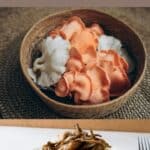
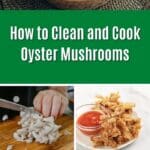
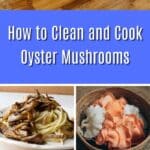


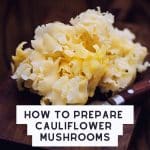
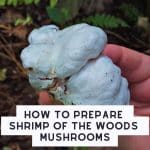
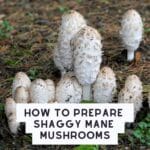
Sarah B Larrabee says
have you ever roasted a whole colony or cluster of oyster mushrooms?
I thought it would be pretty on a platter- pretty dramatic that is.
what would be the time and temp?
Jenny says
I’ve never done that but it sounds like a phenomenal idea. If you do it, I’d love to hear how it comes out!